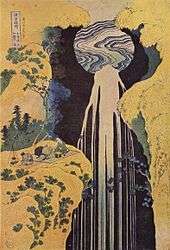A Tour of the Waterfalls of the Provinces
.jpg)
A Tour of the Waterfalls of the Provinces (Japanese:Shokoku taki meguri) is a series of landscape woodblock prints by the Japanese Ukiyo-e artist Hokusai[1] (October 31, 1760 (exact date questionable) – May 10, 1849). The series contains eight prints (completed ca. 1833-34) in which the author expressed his Shintoist beliefs, being the first Ukiyo-e artist to approach the theme of falling water.[2]
Background
In Japan's Shintoist religion, gods and spirits inhibit the surrounding nature, such as trees, rocks or animals. In the Waterfall series, using newly imported blue Prussian pigment that was fashionable at that time, Hokusai paints each waterfall differently, in order to emphasize the unique beauty of each site and to outline his belief that water was sacred.
Content

The waterfalls Hokusai chose to illustrate are located in the central, western and eastern parts of Japan's main island (Honshu). The regions chosen were well known for pilgriming and by the travelers of his time, while three of the waterfalls, Kirifuri, Amida and Yōrō, are among Japan's 100 most beautiful even today. All the prints are in vertical format and in their composition there is sometimes included human or animal forms which appear to be insignificant in front of the plummeting water. Unlike most of his other works, in the Waterfalls series Hokusai uses more color, in order to highlight the new and main theme: the falling water.[3] Besides using imported blue pigments either from Berlin or Prussia, the artist also adds contrasting yellows, browns and greens to paint the surrounding forested mountains.
Series
Even though Thirty-six Views of Mount Fuji (富嶽三十六景 Fugaku Sanjūroku-kei?, c. 1831) was Hokusai’s most popular series, A Tour of the Waterfalls of the Provinces is believed to be his finest work in the series , both technically and culturally speaking. Adding to the series' cultural value is the religious subtext, the references to the original Shinto belief of Japan’s indigenous people. The followers of Shinto often practice rituals of purification under waterfalls and they aim to become like the water flow and be able to transcend all boundaries. Hokusai's belief that water is sacred[4] and waterfalls are able to purify and restore life makes the series culturally aware and abundant.
References
- ↑ Lane, Richard (1989). Hokusai: life and work. Arrow.
- ↑ Forrer, Matthi; Hokusai, Katshushika (1991). Hokusai: prints and drawings. Prestel.
- ↑ Nagata, Seiji; Hokusai, Katsushika (1999). Hokusai: genius of the Japanese ukiyo-e. Oxford University Press.
- ↑ Lane, Richard (1989). Hokusai: life and work. Arrow.